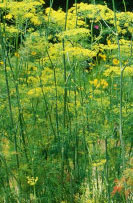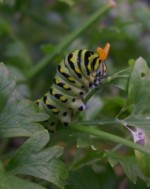 Dill is a cool weather annual and a member of the carrot family, Apiaceae, that also includes celery, sea holly, and Queen Anne’s lace. It is native to northern Africa and the Arabian peninsular but is widely grown in Europe where its seeds and leaves are used as a culinary herb. Plants grow 2-5′ tall and have stiff hollow stems and fragrant, blue-green leaves that are pinnately divided into fine segments. In mid-summer flat, compound umbels up to 10″ across appear bearing small yellow flowers that give way to aromatic seeds. The plant attracts numerous beneficial insects and is the larval plant for the black swallowtail butterfly. The leaves are best used fresh, may be frozen, but lose flavor quickly when dried; the seed can be used fresh or dried. Dill is an attractive plant and is lovely in the border as well as in the herb garden. The genus name, Anethum, is from the Greek name for the plant. The specific epithet, graveolens, is probably related to the Latin word gravis meaning heavy, and refers to the scent.
Dill is a cool weather annual and a member of the carrot family, Apiaceae, that also includes celery, sea holly, and Queen Anne’s lace. It is native to northern Africa and the Arabian peninsular but is widely grown in Europe where its seeds and leaves are used as a culinary herb. Plants grow 2-5′ tall and have stiff hollow stems and fragrant, blue-green leaves that are pinnately divided into fine segments. In mid-summer flat, compound umbels up to 10″ across appear bearing small yellow flowers that give way to aromatic seeds. The plant attracts numerous beneficial insects and is the larval plant for the black swallowtail butterfly. The leaves are best used fresh, may be frozen, but lose flavor quickly when dried; the seed can be used fresh or dried. Dill is an attractive plant and is lovely in the border as well as in the herb garden. The genus name, Anethum, is from the Greek name for the plant. The specific epithet, graveolens, is probably related to the Latin word gravis meaning heavy, and refers to the scent.
Type: Annual herb.
Bloom: Small yellow flowers with tiny petals rolled inward are borne in flat topped umbrella like structures called compound umbels.
Foliage: Feathery, blue-green, compound leaves.
Size: 2-5’ x 1-2’ W.
Light: Full sun.
Soil: Moderately rich, moist, well-drained; pH 6-7.5.
Fertilizer: Fertilize with cottonseed meal or bloodmeal.
Care: Water weekly during dry weather.
Pests and Diseases: Susceptible to horn worms, aster wilt, and Alternaria blight; are said to attract insects such as aphids and thereby protect other plants from infestation.
Propagation: Seed.
Outstanding Selections: ‘Bouquet’ and ‘Fernleaf’ are best in warm climates because of their tendency to flower and set seeds more slowly than other varieties.

